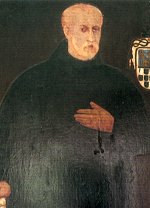
Aleixo de Menezes
Encyclopedia

Braga
Braga , a city in the Braga Municipality in northwestern Portugal, is the capital of the Braga District, the oldest archdiocese and the third major city of the country. Braga is the oldest Portuguese city and one of the oldest Christian cities in the World...
, Portugal
Portugal
Portugal , officially the Portuguese Republic is a country situated in southwestern Europe on the Iberian Peninsula. Portugal is the westernmost country of Europe, and is bordered by the Atlantic Ocean to the West and South and by Spain to the North and East. The Atlantic archipelagos of the...
, and Viceroy of Portugal during the Iberian Union
Iberian Union
The Iberian union was a political unit that governed all of the Iberian Peninsula south of the Pyrenees from 1580–1640, through a dynastic union between the monarchies of Portugal and Spain after the War of the Portuguese Succession...
.
Biographical sketch
Aleixo was born in 1559. It is known that he joined the AugustiniansAugustinians
The term Augustinians, named after Saint Augustine of Hippo , applies to two separate and unrelated types of Catholic religious orders:...
. He was consecrated Archbishop of Goa in 1595, when he was only 35.
As Archbishop of Goa, Menezes focused on strengthening Catholic ascendancy in Portugal. Part of this mission involved bringing the Saint Thomas Christians
Saint Thomas Christians
The Saint Thomas Christians are an ancient body of Christians from Kerala, India, who trace their origins to the evangelical activity of Thomas the Apostle in the 1st century. They are also known as "Nasranis" because they are followers of "Jesus of Nazareth". The term "Nasrani" is still used by St...
, an ancient body formerly part of the Church of the East
Church of the East
The Church of the East tāʾ d-Maḏnḥāʾ), also known as the Nestorian Church, is a Christian church, part of the Syriac tradition of Eastern Christianity. Originally the church of the Persian Sassanid Empire, it quickly spread widely through Asia...
, under the authority of the Catholic Church. By 1597 the last metropolitan bishop
Metropolitan bishop
In Christian churches with episcopal polity, the rank of metropolitan bishop, or simply metropolitan, pertains to the diocesan bishop or archbishop of a metropolis; that is, the chief city of a historical Roman province, ecclesiastical province, or regional capital.Before the establishment of...
of the Saint Thomas Christians, Abraham, had died, and Menezes was able to secure the submission of Archdeacon George, the highest remaining representative of the native church hierarchy. That year Menezes convened the Synod of Diamper
Synod of Diamper
The Synod of Diamper, held at Udayamperoor/Diamper, is a diocesan synod by which Latin usages were formally adopted by the Christians of Saint Thomas. It was convened on June 20, 1599, under the leadership of Aleixo de Menezes, Archbishop of Goa. Archdeacon George was forced to comply with the...
, which introduced a number of reforms to the church and brought it fully into the Latin Rite of the Catholic Church. Following the Synod, Menezes consecrated Francis Ros, S. J. as Archbishop of the Archdiocese of Angamalé for the Saint Thomas Christians.
In 1612 Aleixo de Menezes was appointed Archbishop of Braga, Portugal. He was viceroy of Portugal during the Iberian Union from 1612 to 1615. He died in 1617, his remains are located at the Populo Church
Populo Church
Pópulo Church is a neoclassical church located in Braga.The church started to be built by the end of the 16th century, under the order of Archbishop D...
in Braga.
Controversy
Aleixo de Menezes, under the authority of the Goa InquisitionGoa Inquisition
The Goa Inquisition was the office of the Inquisition acting in the Indian state of Goa and the rest of the Portuguese empire in Asia. It was established in 1560, briefly suppressed from 1774–1778, and finally abolished in 1812. The Goan Inquisition is considered a blot on the history of...
and the Council of Trent
Council of Trent
The Council of Trent was the 16th-century Ecumenical Council of the Roman Catholic Church. It is considered to be one of the Church's most important councils. It convened in Trent between December 13, 1545, and December 4, 1563 in twenty-five sessions for three periods...
, continued the latinisation of the St. Thomas Christians started by the Portuguese
Portuguese people
The Portuguese are a nation and ethnic group native to the country of Portugal, in the west of the Iberian peninsula of south-west Europe. Their language is Portuguese, and Roman Catholicism is the predominant religion....
in the early 16th century.
The result of his Synod of Diamper was unfortunate. The Catholic Encyclopedia
Catholic Encyclopedia
The Catholic Encyclopedia, also referred to as the Old Catholic Encyclopedia and the Original Catholic Encyclopedia, is an English-language encyclopedia published in the United States. The first volume appeared in March 1907 and the last three volumes appeared in 1912, followed by a master index...
(1913) says:
The only case in which an ancient Eastern rite has been wilfully romanized is that of the Uniat Malabar Christians, where it was not Roman authority but the misguided zeal of Alexius de Menezes, Archbishop of Goa, and his Portuguese advisers at the Synod of Diamper (1599) which spoiled the old Malabar Rite.
See also
- NasraniSyrian Malabar NasraniThe Syrian Malabar Nasrani people, also known as Saint Thomas Christians, "'Nasrani Mappila'" and Nasranis, are an ethnoreligious group from Kerala, India, adhering to the various churches of the Saint Thomas Christian tradition...
- Syro-Malabar Church
- Syro-Malankara Catholic ChurchSyro-Malankara Catholic ChurchThe Syro-Malankara Catholic Church is an Eastern Catholic Church in full communion with the Holy See...

